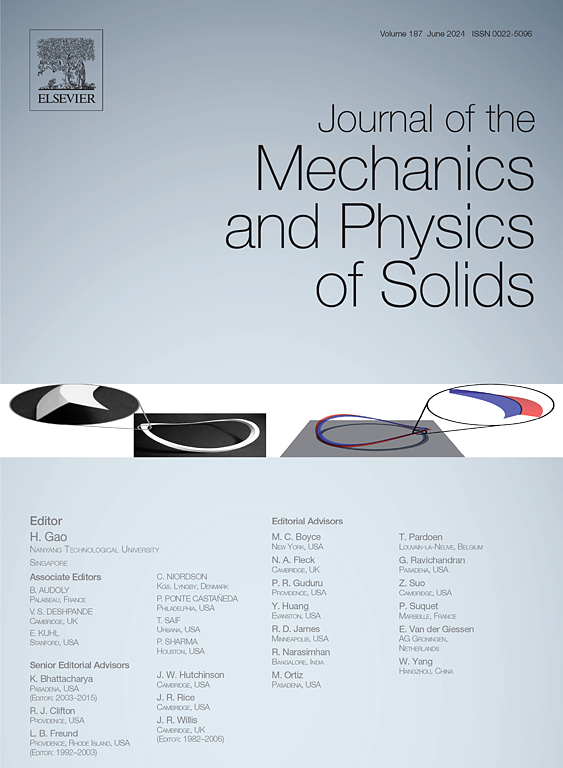受渗透压作用的多种弯曲蛋白包埋的膜泡
IF 6
2区 工程技术
Q2 MATERIALS SCIENCE, MULTIDISCIPLINARY
引用次数: 0
摘要
具有不同力学的生物膜对于许多重要的生物过程(例如,内吞作用,代谢和细胞间运输)至关重要,这些过程需要特定的细胞或细胞器膜形状才能成功实现相关的细胞功能。在生物系统中,膜形态会同时受到曲率传感蛋白和渗透压的调节。然而,在膜变形过程中,这两种生物物理因素与膜力学之间的潜在力学相互作用在很大程度上仍不清楚。为了解决这一问题,我们利用动态三角蒙特卡罗模拟了渗透压力下嵌入多种弯曲蛋白质的膜囊泡,研究了囊泡系统的随机动力学和热平衡构型。这种随机方法捕获了一系列微观随机行为,包括膜波动、蛋白质运动和囊泡收缩。一项比较研究揭示了渗透压和弯曲蛋白对囊泡形态的协同作用,依赖于膜力学。在弹性膜中,仅渗透压就会形成凹形,而弯曲的蛋白质则会形成粗糙的准球形结构;它们的组合协同形成高度折叠、低体积面积比的形态。在流体膜中,由于膜张力增加,渗透压抑制由弯曲蛋白驱动的管状结构。不同的动态和平衡构型被确定为溶液浓度、蛋白质曲率和膜力学的函数,与先前的文献一致。这些发现提供了渗透压和曲率传感蛋白如何共同调节囊泡变形的机械理解。本文章由计算机程序翻译,如有差异,请以英文原文为准。
Membrane vesicles embedded with multiple curved proteins subjected to osmotic pressure
Biological membranes with distinct mechanics are crucial for many important biological processes (e.g., endocytosis, metabolism and intercellular trafficking) that require specific cell or organelle membrane shape for successful implementation of relevant cellular functions. In biological systems, the membrane morphology would be simultaneously modulated by curvature-sensing proteins and osmotic pressure. However, the underlying mechanical interplay among these two biophysical factors and the membrane mechanics remains largely unclear during membrane deformation. To address this issue, using dynamic triangulation Monte Carlo simulations of membrane vesicles embedded with multiple curved proteins under osmotic pressure, we investigate the stochastic dynamics and thermal equilibrium configurations of the vesicle system. This stochastic method captures a range of microscopic stochastic behaviors, including membrane fluctuations, protein motion, and vesicle shrinkage. A comparative study reveals the cooperative effects of osmotic pressure and curved proteins on vesicle morphology, dependent on membrane mechanics. In elastic membranes, osmotic pressure alone induces concave shapes, while curved proteins create rough quasi-spherical structures; their combination synergistically forms highly folded, low volume-to-area ratio morphologies. In fluid membranes, osmotic pressure inhibits tubular structures driven by curved proteins due to increased membrane tension. Diverse dynamic and equilibrium configurations are identified as functions of solution concentration, protein curvature, and membrane mechanics, consistent with prior literature. These findings provide a mechanical understanding of how osmotic pressure and curvature-sensing proteins jointly regulate vesicle deformation.
求助全文
通过发布文献求助,成功后即可免费获取论文全文。
去求助
来源期刊
CiteScore
9.80
自引率
9.40%
发文量
276
审稿时长
52 days
期刊介绍:
The aim of Journal of The Mechanics and Physics of Solids is to publish research of the highest quality and of lasting significance on the mechanics of solids. The scope is broad, from fundamental concepts in mechanics to the analysis of novel phenomena and applications. Solids are interpreted broadly to include both hard and soft materials as well as natural and synthetic structures. The approach can be theoretical, experimental or computational.This research activity sits within engineering science and the allied areas of applied mathematics, materials science, bio-mechanics, applied physics, and geophysics.
The Journal was founded in 1952 by Rodney Hill, who was its Editor-in-Chief until 1968. The topics of interest to the Journal evolve with developments in the subject but its basic ethos remains the same: to publish research of the highest quality relating to the mechanics of solids. Thus, emphasis is placed on the development of fundamental concepts of mechanics and novel applications of these concepts based on theoretical, experimental or computational approaches, drawing upon the various branches of engineering science and the allied areas within applied mathematics, materials science, structural engineering, applied physics, and geophysics.
The main purpose of the Journal is to foster scientific understanding of the processes of deformation and mechanical failure of all solid materials, both technological and natural, and the connections between these processes and their underlying physical mechanisms. In this sense, the content of the Journal should reflect the current state of the discipline in analysis, experimental observation, and numerical simulation. In the interest of achieving this goal, authors are encouraged to consider the significance of their contributions for the field of mechanics and the implications of their results, in addition to describing the details of their work.

 求助内容:
求助内容: 应助结果提醒方式:
应助结果提醒方式:


